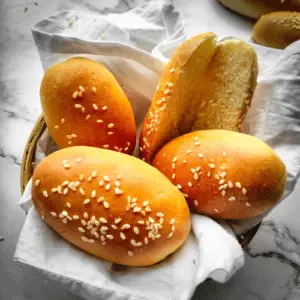Welcome back to your favorite desserts and baking blog:)
Chances are you right now have a dough that looks absolutely sticky or just not right. In this post “What does overworked dough look like?“, you will get to know:
What does overworked dough look like?
How do you know if you overworked dough?
Is overworked dough sticky?
Why knead the bread dough?
What does overworked dough look like?
Overworked or over kneaded dough will look sticky and it will feel soft. When you pull this dough, it will not stretch, instead it will tear into smaller pieces. This is because the gluten has been stretched and pulled so much that it has now reached a stage that is known as “Letdown stage” , which is a stage characteristic of yeast leavened bread doughs when it is kneaded too much.
How do you know if you overworked dough?
If you are kneading by hand, chances of overworking the dough will be nearly impossible even if you are the owner of ripped abs. However, if you kneading the dough using machine, then chances of over working the dough becomes significantly high. When you are using a machine to knead your bread dough, the bread dough will go through some stages.
Initially it will be sticky and will stick to the bowl of the machine. However, slowly it will stop sticking to the machine bowl. This is the perfect time to do your window pane test. If the dough passes the window pane test and is not sticking to the sides of the bowl then your dough is done. Do not knead it any more.
If you continue kneading, you will notice that the dough starts becoming sticky again, as the gluten bonds are broken due to over mixing.
Another point to keep in mind is high hydration doughs. High hydration doughs are very sticky and thus won’t leave the sides of the machine bowl or would be able to pass the window pane test. Usually, you can just knead it for 4-8 minutes and then let it rest and start folding it to strengthen the dough.
Also make sure you are not overmixing richer doughs like brioche and croissants, as they tend to create gluten network faster.
Is overworked dough sticky?
Yes, overworked dough will become sticky and soft. The gluten that had been created breaks down and thereby the dough loses it’s shape and structure. It will start tearing into smaller pieces as the gluten strands have snapped and broken down. It is unable to retain water or carbon dioxide.
How do you know if dough is properly kneaded?
If you are kneading the dough using a machine, then initially it will be sticky and will stick to the bowl of the machine. However, slowly it will stop sticking to the machine bowl. This is the perfect time to do your window pane test.
Take a small piece of the dough and make a roundel. Now start stretching it from all sides till you get a thin stretched piece of dough. You should be able to see through that dough, just like a window, therefore it is called the window pane test.
If the dough passes the window pane test and is not sticking to the sides of the bowl then your dough is done. Do not knead it any more.
If you still feel confused, check for these 7 signs to know that your dough is kneaded over here.
Why is my dough still sticky after kneading?
If you have been kneading the dough by hand, then it can be sticky because it has not been kneaded enough. It is impossible to overmix or over knead the dough if kneading by hand as your hands will tire out before you end up kneading it too much.
What does overwork the dough mean?
Overworking the dough means that you have overhandled or over kneaded the dough than required.
How do you know that the dough is overhydrated?
Some recipes call for higher levels of hydration. However, you may end up adding more water accidentally. That is when your dough is over hydrated. However you can still save it. You can fold the dough multiple times in half an hour intervals to strengthen it and make the gluten bonds stronger.
How to fix overworked dough?
In case you have overworked dough, essentially, you have stretched and pulled the gluten strands considerably. The solution is to let the gluten strands relax. Cover and leave it in the refrigerator for overnight fermentation. The longer fermentation time, ensures that the gluten strands are well rested and strong.
During shaping, try to handle it as less as possible. When proofing, give it a little longer proofing time.
in case you ended up baking the overworked dough, an easy way to use it would be to turn it into bread crumbs. The bread turns out to have low volume and coarse crumb.
How to turn overworked dough into breadcrumbs?
Cut the bread into small dices or cubes. Bake it in the oven at 200 degrees Celsius (392 degrees Fahrenheit) for 15 minutes
Let it cool.
Grind it into fine breadcrumbs in a mixer or a food processor.
Use it to crumb coat chicken nuggets, cutlets, make pakoras, in sandwich fillings.
Still have doubts? Skip kneading altogether with my no knead bread recipe. Check it out over here.
Popular bread recipes:
[CLICK ON THE IMAGE FOR THE RECIPE]

FOUND IT HELPFUL?
Tag @alishasdessertsafari on Instagram and hashtag it #alishasdessertsafari
Don’t forget to Subscribe to get new recipes every week because you will love it!
Follow me on social media to get more BTS, baking tips, launches and daily updates.
I hope you found my post “What does overworked dough look like?” helpful. If you have any queries, feel free to post them in the comments below.
Thank You.






